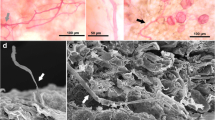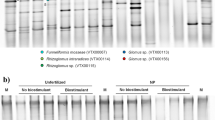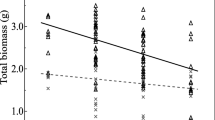Abstract
This study is the first in assessing the effect of soil disturbance on the contribution of arbuscular mycorrhizal fungi (AMF) with different life-history strategies to the tripartite symbiosis with soybeans and Bradyrhizobium japonicum (Kirchner) Jordan. We hypothesized that Gigaspora margarita Becker and Hall would be more affected by soil disturbance than Glomus clarum Nicol. and Schenck, and consequently, the tripartite symbiosis would develop more rapidly and lead to greater N2 fixation in the presence of the latter. Soil pasteurization allowed the establishment of treatments with individual AMF species and soil disturbance enabled the development of contrasting root colonization potentials. In contrast, the colonization potential of B. japonicum was kept the same in all treatments. Soil disturbance significantly reduced root colonization by both AMF, with Gi. margarita being considerably more affected than G. clarum. Furthermore, the tripartite symbiosis progressed faster with G. clarum, and at 10 days after plant emergence, there was 30% more nodules when G. clarum was present compared to that when the bacterial symbiont alone was present. At flowering, the absence of soil disturbance stimulated N2 fixation by 17% in mycorrhizal plants. However, this response was similar for both AMF.


Similar content being viewed by others
References
Ames RN, Bethlenfalvay GJ (1987) Localized increase in nodule activity but no competitive interaction of cowpea rhizobia due to pre-establishment of vesicular-arbuscular mycorrhiza. New Phytol 106:207–215
Ames RN, Mihara KL, Bethlenfalvay GJ (1987) The establishment of microorganisms in vesicular-arbuscular mycorrhizal and control treatments. Biol Fertil Soils 3:217–223
Antunes PM, Rajcan I, Goss MJ (in press) Specific flavonoids as interconnecting signals in the tripartite symbiosis formed by arbuscular mycorrhizal fungi, Bradyrhizobium japonicum (Kirchner) Jordan and soybean (Glycine max (L.) Merr.). Soil Biol Biochem
Bayne HG, Bethlenfalvay GJ (1987) The Glycine–Glomus–Rhizobium symbiosis. IV. Interaction between the mycorrhizal and nitrogen-fixing endophytes. Plant Cell Environ 10:607–612
Biermann B, Linderman RG (1983) Use of vesicular-arbuscular mycorrhizal roots, intraradical vesicles and extraradical vesicles as inoculum. New Phytol 95:97–105
Boddington C, Dodd J (1999) Evidence that differences in phosphate metabolism in mycorrhizas formed by species of Glomus and Gigaspora might be related to their life cycle strategies. New Phytol 142:531–538
Brundrett MC, Juniper S (1993) Non-destructive assessment of spore germination and single spore culture isolation of VAM fungi. Poster presented at the 9th NACOM, Guelph
Brundrett MC, Piché Y, Peterson RL (1984) A new method for observing the morphology of vesicular-arbuscular mycorrhizae. Can J Bot 62:2128–2134
Conover WJ, Johnson ME, Johnson MM (1981) A comparative study of tests of homogeneity of variances, with applications to the outer continental shelf bidding data. Technometrics 23:351–361
Fried M, Middelboe V (1977) Measurement of amount of nitrogen fixed by a legume crop. Plant Soil 47:713–715
Ganry F, Diem HG, Dommergues YR (1982) Effect of inoculation with Glomus mosseae on nitrogen fixation by field grown soybeans. Plant Soil 47:713–715
George E, Marschner H, Jakobsen I (1995) Role of arbuscular mycorrhizal fungi in uptake of phosphorus and nitrogen from soil. Crit Rev Biotechnol 15:257–270
Goss MJ, de Varennes A (2002) Soil disturbance reduces the efficacy of mycorrhizal associations for early soybean growth and N2 fixation. Soil Biol Biochem 34:1167–1173
Goss MJ, de Varennes A, Smith PS, Ferguson JA (2002) N2 fixation by soybeans grown with different levels of mineral nitrogen, and the fertilizer replacement value for a following crop. Can J Soil Sci 82:139–145
Hart MM, Reader RJ (2002) Taxonomic basis for variation in the colonization strategy of arbuscular mycorrhizal fungi. New Phytol 153:335–344
Helgason T, Daniell TJ, Husband R, Fitter AH, Young JPW (1998) Ploughing up the wood-wide web? Nature 394:431–431
Ianson DC, Linderman RG (1993) Variation on the response of nodulating pigeonpea (Cajanus cajan) to different isolates of mycorrhizal fungi. Symbiosis 15:105–119
Ibijbijen J, Urquiaga S, Ismaili M, Alves BJR, Boddey RM (1996) Effect of arbuscular mycorrhizal fungi on growth, mineral nutrition and nitrogen fixation of three varieties of common beans (Phaseolus vulgaris). New Phytol 134:353–360
Jakobsen I, Abbot LK, Robson AD (1992) External hyphae of vesicular-arbuscular mycorrhizal fungi associated with Trifolium subterraneum L. 2. Hyphal transport of 32P over defined distances. New Phytol 120:371–380
Kawai Y, Yamamoto Y (1986) Increase in the formation and nitrogen fixation of soybean nodules by vesicular-arbuscular mycorrhiza. Plant Cell Physiol 27:399–405
Keeney DR, Nelson DW (1982) Nitrogen-inorganic forms. In: Page AL, Miller RH, Keeney DR (eds) Methods of soil analysis, 2nd edn. Soil Science Society of America, Madison, pp 643–698
Klironomos JN, Hart MM (2002) Colonization of roots by arbuscular mycorrhizal fungi using different sources of inoculum. Mycorrhiza 12:181–184
Knudsen D, Peterson GA, Pratt PF (1982) Lithium, sodium and potassium. In: Page AL, Miller RH, Keeney DR (eds) Methods of soil analysis, 2nd edn. Soil Science Society of America, Madison, pp 225–246
Kruskal WH, Wallis WA (1952) Use of ranks in one-criterion variance analysis. J Am Stat Assoc 47:583–621
McGonigle TP, Miller MH (1996) Mycorrhizae, phosphorus absorption, and yield in response to tillage. Soil Sci Soc Am J 60:1856–1861
McGonigle TP, Miller MH, Evans DG, Fairchild GL, Swan JA (1990) A new method which gives an objective measure of colonization of roots by vesicular-arbuscular mycorrhizal fungi. New Phytol 115:495–501
Meyer JR, Linderman RG (1986) Response of subterranean clover to dual inoculation with vesicular-arbuscular mycorrhizal fungi and a plant growth-promoting bacterium, Pseudomonas putida. Soil Biol Biochem 18:191–196
Miller MH, McGonigle TP, Addy HD (1995) Functional ecology of vesicular arbuscular mycorrhizas as influenced by phosphate fertilization and tillage in an agricultural ecosystem. Crit Rev Biotechnol 15:241–255
Morton JP (1993) Properties of infective propagules at the sub-order level (Glominae versus Gigasporineae). INVAM Newsletter 3
Morton JB, Benny GL (1990) Revised classification of arbuscular mycorrhizal fungi (Zygomycetes): a new order, Glomales, two new suborders, Glomineae and Gigasporineae, and two new families, Acaulosporaceae and Gigasporaceae, with an emendation of Glomaceae. Mycotaxon 37:471–491
Mulvaney RL (1993) Mass spectrometry. In: Knowles R, Blackburn TH (eds) Nitrogen isotope techniques. Academic, San Diego, pp 11–57
Oehl F, Sieverding E, Ineichen K, Mäder P, Boller T, Wiemken A (2003) Impact of land use intensity on the species diversity of arbuscular mycorrhizal fungi in agroecosystems of central Europe. Appl Environ Microbiol 69:2816–2824
Olsen SR, Summers LE (1982) Phosphorus. In: Page AL, Miller RH, Keeney DR (eds) Methods of soil analysis, 2nd edn. Soil Science Society of America, Madison, pp 403–430
Saxena AK, Rathi SK, Tilak KVBR (1997) Differential effect of various endomycorrhizal fungi on nodulating ability of green gram by Bradyrhizobium sp. (Vigna) strain S24. Biol Fertil Soils 24:175–178
Scheublin TR, Karyn PR, Young JPW, van der Heijden MGA (2004) Nonlegumes, legumes, and root nodules harbour different arbuscular mycorrhizal fungal communities. Appl Environ Microbiol 70:6240–6246
Shapiro SS, Wilk MB, Chen HJ (1968) A comparative study of various tests of normality. J Am Stat Assoc 63:1343–1372
Smith FA, Jakobsen I, Smith SE (2000) Spatial differences in acquisition of soil phosphate between two arbuscular mycorrhizal fungi in symbiosis with Medicago truncatula. New Phytol 147:357–366
Smith SE, Smith FA, Jakobsen I (2004) Functional diversity in arbuscular mycorrhizal (AM) symbioses: the contribution of the mycorrhizal P uptake pathway is not correlated with mycorrhizal responses in growth or total P uptake. New Phytol 162:511–524
Tommerup IC (1992) Methods for the study of the population biology of vesicular-arbuscular mycorrhizal fungi. In: Norris JR, Read DJ, Varma AK (eds) Methods in microbiology, vol 24. Techniques for the study of mycorrhiza. Academic, New York, pp 23–51
Tukey JW (1949) Comparing individual means in the analysis of variance. Biometrics 5:99–114
Van der Heijden MGA, Boller T, Wiemken A, Sanders IR (1998) Different arbuscular mycorrhizal fungal species are potential determinants of plant community structure. Ecology 79:2082–2091
van Nuffelen M, Schenck NC (1984) Spore germination, and root colonization of six species of vesicular-arbuscular mycorrhizal fungi on soybean. Can J Bot 62:624–628
Vejsadová H, Siblíková D, Gryndler M, Simon T, Miksik I (1993) Influence of inoculation with Bradyrhizobium japonicum and Glomus claroideum on seed yield of soybean under greenhouse and field conditions. J Plant Nutr 16:619–629
Xavier LJC, Germida J (2003) Selective interactions between arbuscular mycorrhizal fungi and Rhizobium leguminosarum bv. viceae enhance pea yield and nutrition. Biol Fertil Soils 37:261–267
Acknowledgements
The research was carried out under the Land Stewardship Chair Program at the University of Guelph. P.M.A. thanks the Foundation for Science and Technology of Portugal for the financial support. We are grateful to Julia Zilka and Miranda Labbe for technical support, and to Dr. Miranda M. Hart for her suggestions regarding the content and organization.
Author information
Authors and Affiliations
Corresponding author
Rights and permissions
About this article
Cite this article
Antunes, P.M., Deaville, D. & Goss, M.J. Effect of two AMF life strategies on the tripartite symbiosis with Bradyrhizobium japonicum and soybean. Mycorrhiza 16, 167–173 (2006). https://doi.org/10.1007/s00572-005-0028-3
Received:
Accepted:
Published:
Issue Date:
DOI: https://doi.org/10.1007/s00572-005-0028-3




